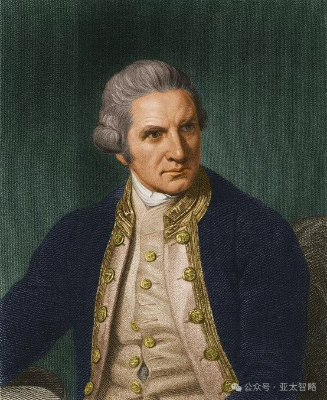读书||《湛蓝之海》:重审詹姆斯·库克船长
来源:The New York Times
原名:What Happened When Captain Cook Went Crazy
ByDoug Bock Clark
编译:薛金钥
校对:彭宇
时间:2024年4月10日
1779年1月,英国探险家詹姆斯·库克驶入被当地人称为“神之道”的火山湾,登陆时迎来数千夏威夷人的热烈欢迎,并被尊为“Lono”——夏威夷的神祇之一。美国作家汉普顿·塞兹在《湛蓝之海》(The Wide Wide Sea)一书中记录了这一场景,书中讲述了库克无意中参与了一场关于神Lono的祭祀仪式,因而可能被误认为是神明。
塞兹,这位战争和探险作品的作者,通过描述库克的最后一次航行,呈现了一个道德复杂的故事,探讨了“欧洲中心主义”、“有毒男性气质”以及“文化挪用”等诸多议题。虽然库克探险是为了科学探究,但他的最后一次航行却与殖民主义紧密关联。探险期间,应一位波利尼西亚青年的请求,库克将其带往伦敦,并试图在回程中找到一条连接太平洋和大西洋的西北航道。《湛蓝之海》不仅叙述了“首次接触”的故事,还思考了库克在扩展欧洲版图中对土著群体带来的影响。塞兹回顾了库克早期的航程,指出其对被“发现”群体产生了不利影响,如梅毒的传播等。书中提到,库克试图阻止船员登陆夏威夷岛,以避免疾病传播。他还试图避免介入土著文明间的“政治纷争”。

但在库克的最后旅程中,人们对库克的行为是否有遵守公正观察这一原则展开了激烈的讨论。例如,库克对一起盗窃事件的过度反应,引起了船员们对其精神状况的担忧,书中也指出库克不稳定的健康状况可能影响了他的情绪和行为。虽然读者很少能从库克真实的日记和日志中窥见他的情感世界,但《湛蓝之海》这部作品以生动的笔触描绘了库克的数次航行经历,包括在新西兰、大溪地、堪察加半岛以及夏威夷等地的探索,同时通过库克的视角展示了辛勤的探索与忍耐,弥补了库克情感世界的空白。
塞兹的《湛蓝之海》试图从21世纪的视角重新审视这一段历史,并将其放在殖民主义背景下进行解读。通过口述历史,塞兹呈现了夏威夷人和其他土著群体的观点,同时也描绘了英国帝国和古代波利尼西亚文化的生动形象。然而,这种现代解读也引发了对历史故事新旧版本之间差异的反思。《湛蓝之海》虽批判性地重新叙述了库克的旅程,但某些部分不可避免地与早期版本产生了共鸣。在故事的最后,夏威夷人终于意识到库克并非神明。在耗尽资源和装备船只后,库克试图绑架夏威夷国王来收回被盗船只,这造成双方冲突,最终导致了库克的死亡。
.jpg)
塞兹通过《湛蓝之海》为人们提供了库克故事的新视角,同时也分析了库克的行为和后果,呈现了一个不仅是科学探索,更是殖民主义、文化碰撞和权力斗争的历史画卷。这部作品为人们提供了反思和重新审视历史事件的机会,强调了在当代重新审视历史故事的重要性,呼吁人们更全面、客观地理解过去并应对复杂的历史遗产。
In January 1779, British explorer James Cook sailed into a volcanic bay known by the locals as the “Pathway of the Gods,” where he was greeted by thousands of Hawaiians with great enthusiasm and revered as “Lono” - one of the gods of Hawaii. This scene is recorded in the book “The Wide Wide Sea” by American writer Hampton Sides, which recounts Cook’s unintentional involvement in a ritual ceremony about the god Lono, potentially leading to him being mistaken for a deity. Sides, the author of works on war and exploration, presents a morally complex story through his description of Cook’s final voyage, exploring various themes including “Eurocentrism,” “toxic masculinity,” and “cultural appropriation.”
While Cook’s expeditions aimed at scientific inquiry, his final voyage was closely linked to colonialism. During this journey, at the request of a Polynesian youth, Cook brought him to London and attempted to find a Northwest Passage between the Pacific and Atlantic oceans on his return voyage. “The Wide Wide Sea” not only narrates the story of “first contact” but also reflects on the consequences Cook’s expansion of European territory had on indigenous communities. Sides revisits Cook’s earlier voyages, pointing out the adverse effects they had on the “discovered” populations, such as the spread of diseases like syphilis. The book mentions Cook’s attempts to prevent his crew from landing on the Hawaiian Islands to avoid the spread of illness and his efforts to avoid involvement in “political disputes” among indigenous civilizations. However, during Cook’s final journey, intense debates arose over whether his actions adhered to the principle of impartial observation. For example, Cook’s exaggerated reaction to a theft incident raised concerns among the crew about his mental state, and the book also suggests that Cook’s unstable health condition may have influenced his emotions and behavior. Although readers rarely glimpse into his emotional world through Cook’s authentic diaries and logs, “The Wide Wide Sea” vividly portrays Cook’s multiple voyages, including explorations of New Zealand, Tahiti, the Kamchatka Peninsula, and Hawaii, among others, showcasing diligent exploration and endurance through Cook’s perspective, filling the gaps in his emotional world.
Sides’ “The Wide Wide Sea” attempts to reexamine this period of history from a 21st-century perspective, interpreting it within the context of colonialism. Through oral history, he presents the perspectives of the Hawaiian people and other indigenous groups, while also depicting vivid images of the English empire and ancient Polynesian culture. However, this modern interpretation also provokes reflections on the differences between new and old versions of historical stories. While “The Wide Wide Sea” critically retells Cook’s journey, certain parts inevitably resonate with earlier versions.
In the end, the Hawaiians finally realized that Cook was not a deity. After exhausting resources and equipping his ship, Cook attempted to kidnap the Hawaiian king to reclaim stolen vessels, leading to a conflict that resulted in Cook’s death. Through “The Wide Wide Sea,” Sides provides a new perspective on Cook’s story, while also presenting an analysis of Cook’s actions and consequences, depicting a history that is not only about scientific exploration but also about colonialism, cultural collision, and power struggles. This work offers us an opportunity to reflect on and reconsider historical events, emphasizing the importance of reexamining historical narratives in contemporary times and calling for a more comprehensive and objective understanding of the past to address its complex legacies.
转载自:亚太智略


